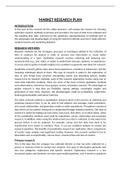MARKET RESEARCH PLAN
INTRODUCTION
In this part of the research for the coffee business I will analyse the reasons for choosing
particular research methods as primary and secondary, the type of data to be collected and
the sampling plan. Also, comment on the usefulness, appropriateness of methods such as
the advantages and disadvantages of using the selected methods and how it helps with the
market research and marketing objective.
RESEARCH METHODS
Research methods are the strategies, processes or techniques utilized in the collection of
data or evidence for analysis in order to uncover new information or create better
understanding of a topic. Qualitative research involves collecting and analysing non-
numerical data (e.g., text, video, or audio) to understand concepts, opinions, or experiences.
It can be used to gather in-depth insights into a problem or generate new ideas for research.
Qualitative research gathers data about lived experiences, emotions or behaviours, and the
meanings individuals attach to them. This type of research is useful in the exploration of
how or why things have occurred, interpreting events and describing actions. Quality
research has its research methods, each of the research approaches involve using one or
more data collection methods. There are some of the most common qualitative methods
such observations, interviews, focus groups, surveys, secondary research. The advantages of
quality research is that they are flexibility, natural settings, meaningful insights and
generation of new ideas. However, the disadvantages could be unreliability, subjectivity,
limited generalizability and labour-intensive.
The other research method is quantitative research which is the process of collecting and
analysing numerical data. It can be used to find patterns and averages, make predictions,
test causal relationships, and generalize results to wider populations. This gathers numerical
data which can be ranked, measured or categorised through statistical analysis. This type of
research is useful for finding out how many, how much, how often, or to what extent. Some
of the quantitative methods used could be experiment, survey, observation and secondary
research. In addition, when using this method and once data is collected, it may need to be
process before it can be analysed. For example, survey and test data may need to be
transformed from words to numbers. Then, it can use statistical analysis to answer the
research questions. The benefits of quantitative research are replication, direct comparisons
of results, large samples and hypothesis testing. However, this research method it has its
downsides such as superficiality, narrow focus, structural bias and lack of context.
Primary research
This is the data that the company has collected directly or that has been collected by a
person or business hired to conduct the research. This type of information generally falls
into two categories: exploratory and specific research. Exploratory research is a less
structured option and functions via more open-ended questions, and it results in questions
, or issues being presented that the company may need to address. Specific research finds
answers to previously identified issues that are often brought to attention through
exploratory research.
The purpose of primary research is to gather information and answer questions that have
not been asked before. One of the most important advantages is, data collected is first-hand
and is accurate. In other words, there is no dilution of data. Also, this research method can
be customized to suit personal requirements and needs of the businesses. However, one
disadvantage is, it can be quite expensive to conduct. One may be required to spend a huge
sum of money depending on the setup or primary research method used. Not all businesses
may be able to spend a considerable amount of money.
During the initial market research plan, two primary research methods will be carried out.
One primary method will be competitive analysis, this means that I have to visit the
competition regularly. The second primary method that will be carried out is a
questionnaire. They are a simple way to gather short responses to questions from people.
This will allow me to find out information such as believes, attitudes and opinions from
people towards coffee.
Competitive analysis
A competitive analysis is a strategy where I can identify major competitors and research
their products, sales, and marketing strategies. I chose this method because by doing this, I
can create solid business strategies which could improve upon the competitors. For
example, I will look at what products or services are being promoted, how their staff works
and how is the environment at the store; as well, how their products and services are
priced and displayed. This information will be useful in forming an effective sales strategy.
Furthermore, if the competition has a website, I will be looking at and reading their blogs
regularly. Also, if the competition uses social media, I should routinely check their postings.
This is an efficient way to view this information, as it gathers company postings from social
sites such as Facebook and Twitter. The number of "likes," as well as customer comments,
can give an idea of a company's popularity in the marketplace.
The advantage of using this method is that enables me to identify what the competitor is
doing right. This information is critical for staying relevant and ensuring both product and
marketing campaigns are outperforming industry standards. Another benefit is that I can
learn through customer reviews what's missing in a competitor's product and consider
how the business might add features to the products to meet those needs. Furthermore,
helps to identify the product's unique value proposition and what makes the product or
service different from competitors', which can inform future marketing efforts. However,
the limitations of this research method is a slow investigation because observation and
analysing is a time taking process. This cannot be hurried; it cannot be completed the
investigation in a short period through observation. Another disadvantage is that this
method is expensive because it requires high cost, plenty of time and hard effort. This
involves travelling, staying at the place and purchasing competitors’ products.




